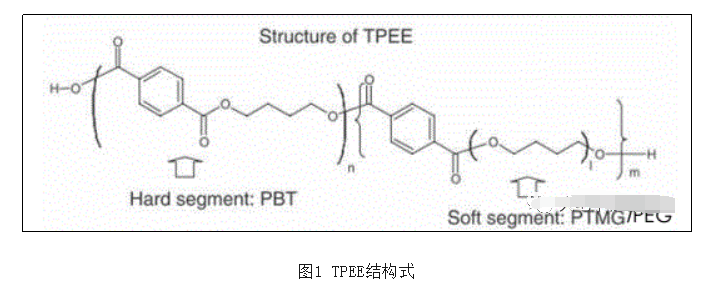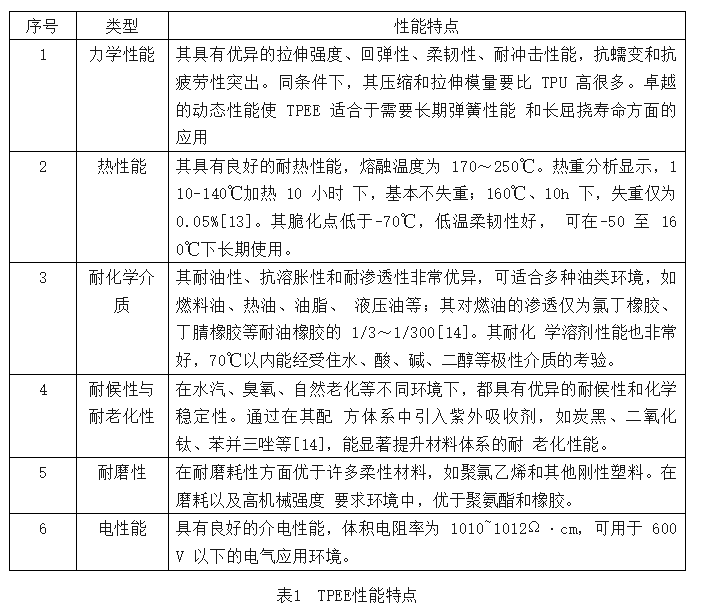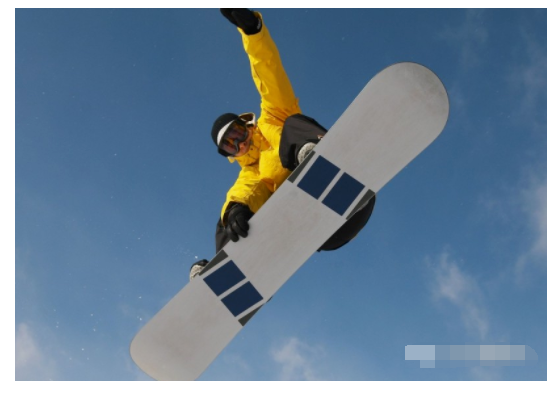Introduction to TPEE and its application of foaming materials
TPEE is a type of polyester hard segment containing PBT (polybutylene terephthalate) and aliphatic Linear block copolymers of polyester or polyether soft segments

According to the structure of the soft segment, TPEE can be divided into polyether type and polyester type Among the two major categories, the comprehensive performance of TPEE is very outstanding, as shown in Table 1

Serial number
Type
Performance characteristics
1
Mechanical properties
It has excellent tensile strength, resilience, flexibility, impact resistance and creep resistance and outstanding fatigue resistance. Under the same conditions, its compression and tensile modulus are much higher than TPU. Excellent dynamic properties make TPEE suitable for applications requiring long-term spring performance and long flex life
2
Thermal properties
It has good heat resistance Performance, melting temperature is 170~250℃. Thermogravimetric analysis shows that when heated at 110-140°C for 10 hours, there is basically no weight loss; when heated at 160°C for 10 hours, the weight loss is only 0.05% [13]. Its embrittlement point is lower than -70℃, it has good low-temperature flexibility and can be used for a long time at -50 to 160℃.
3
Resistant to chemical media
It has excellent oil resistance, swelling resistance and permeability resistance, and can be suitable for a variety of oil environments, such as fuel oil , hot oil, grease, hydraulic oil, etc.; its penetration into fuel is only 1/3 to 1/300 of oil-resistant rubber such as chloroprene rubber and nitrile rubber [14]. Its resistance to chemical solvents is also very good, and it can withstand the test of polar media such as water, acid, alkali, and glycol within 70°C.
4
Weather resistance and aging resistance
It has excellent weather resistance and chemical stability in different environments such as water vapor, ozone, and natural aging. . By introducing UV absorbers, such as carbon black, titanium dioxide, benzotriazole, etc. [14] into its formula system, the aging resistance of the material system can be significantly improved.
5
Abrasion resistance
It is superior to many flexible materials, such as polyvinyl chloride and other rigid plastics, in terms of wear resistance. Superior to polyurethane and rubber in environments requiring abrasion and high mechanical strength.
6
Electrical properties
It has good dielectric properties, with a volume resistivity of 1010~1012Ω·cm, and can be used in electrical application environments below 600V.

TPEE performance characteristics
It can be seen from the structure of TPEE that it not only has the elasticity of rubber, but also has the elasticity of engineering plastics strength. Foam materials have excellent properties such as high resilience, resistance to repeated fatigue, and low-temperature flexibility. Excellent properties such as light weight, shock absorption, and noise reduction make TPEE foam materials have broad application prospects.
1. Highly elastic railway pads
With the demand for high-speed rail speed increase, traditional rubber pads, ethylene vinyl acetate plastic pads, thermoplastic polyurethane pads and other railway pads have been used It’s hard to keep up with demand.
Railway gaskets
2. Outdoor sports products
TPEE foam materials have become outdoor sports products due to their high resilience, resistance to repeated fatigue and low-temperature flexibility. Preferred materials, such as ski cores, ski shoe fasteners, outdoor sports glasses, sports bottles and more.
Outdoor products
3. Shoe materials
The application of TPEE foam shoe materials in sports shoes is because the foaming process is more complicated, and most of them are It is used in EVA rubber-plastic compounding as an auxiliary material to improve the performance of EVA foam shoe materials, while TPEE is used as the main material to prepare foam midsoles.
Shoe midsole
New Materials Co., Ltd. has been deeply involved in the field of TPEE foam materials for many years. In terms of materials, through material compounding, the problems of low melt strength and high foam density of TPEE are solved; in terms of equipment, through precise control of ultra-high pressure and pressure relief speed, accurate cell diameter and density of foam materials are achieved. Regulation. Under the two-way control of materials and equipment, TPEE has good performance, ultra-low density ≤0.1g/cm3, and rebound as high as 80%. .
Control of foam materials with different pore sizes
a




